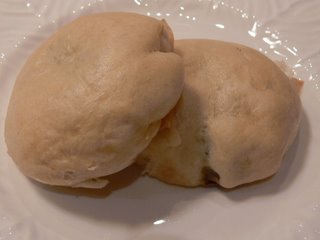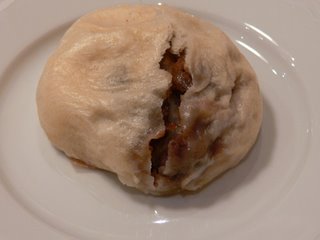 Char siu (see my recipe from last week) on its own is wonderful stuff. Chopped, cooked into a sticky, savoury, meaty mixture and sealed inside a light steamed bun, it becomes something really, really special. It’s a dim sum staple; a filling, moreish little bun of scrumptiousness.
Char siu (see my recipe from last week) on its own is wonderful stuff. Chopped, cooked into a sticky, savoury, meaty mixture and sealed inside a light steamed bun, it becomes something really, really special. It’s a dim sum staple; a filling, moreish little bun of scrumptiousness.
When we’re in Malaysia, my very favourite breakfast is one of these buns. It makes a splendidly fattening change from muesli. Once you have a strip of char siu in the house, the buns are very simple to assemble. They’re also a doddle to reheat – just steam for ten minutes – and they freeze like a dream.
If you made the braised pork with accompanying buns, you’ll recognise the dough recipe here. The method is slightly different, in that you’ll be stuffing your buns before steaming. To make about twenty buns you’ll need:
Filling
1 fillet of char siu (about 10 oz)
2 tablespoons lard
4 fat cloves garlic, chopped finely
1 medium onion, cut into small dice
5 teaspoons caster sugar
2 teaspoons sesame oil
1 teaspoon dark soya sauce
2 teaspoons light soya sauce
4 fl oz water
1 tablespoon plain flour
2 tablespoons vegetable oil
Buns
1 pack instant yeast
1 teaspoon sugar
2 tablespoons lukewarm water
½ tablespoon salt
3 tablespoons vegetable oil
8 tablespoons sugar
8 fl oz lukewarm water
20 oz white flour
 Filling method
Filling method
Cut the char siu strip into tiny cubes with a knife and fork, and blend the vegetable oil and flour in a cup. Fry the garlic in the lard until it starts to turn colour, add the onions and cook until they are translucent. Pour in the sugar, sesame oil, soya sauces and water and bring up to a simmer. Add the chopped meat, stir until well-coated, then add the oil and flour. Continue to simmer for 30 seconds, then transfer to a bowl and chill.
Buns method
Mix the yeast, 1 teaspoon of sugar, two tablespoons of lukewarm water, half a tablespoon of salt and three tablespoons of vegetable oil in a teacup, and let it stand for five minutes.
Place the flour in a bowl and pour the yeast mixture into a depression in the centre of the flour. Add 8 tablespoons of castor sugar and 8 fl oz lukewarm water to the mixture and stir the flour with your hand until everything is brought together.
At this point the dough will be very sticky. Don’t worry – just knead for ten minutes or so, and it will turn smooth and glossy. Don’t add extra flour to get rid of the stickiness. The action of kneading will make the protein strands in the dough develop, and the stickiness will vanish on its own. You’ll know that your dough is ready when it has become smooth, and does not stick to the bowl. Cover the bowl with cling film and leave in a warm place until the dough has doubled in size.
Knock the dough down again, and take an egg-sized piece in the palm of your left hand. Stretch it and squash it on your palm until you have a disc about the size of your hand. Still holding the disc of dough, put a teaspoon and a half of the chilled filling in the centre of the disc, then gather the edges to the centre and pinch closed. Put the pinched side of the bun on a square of greaseproof paper. Leave the filled buns in a warm place until doubled in size.
Steam the buns over boiling water for ten minutes to cook. Once cooked, the buns can be eaten hot (or cold in a packed lunch) – just steam again to reheat. The cooked buns will freeze well; they’ll also keep in the fridge for a few days.
